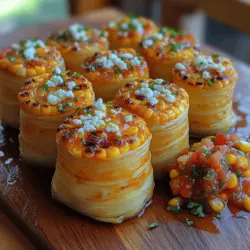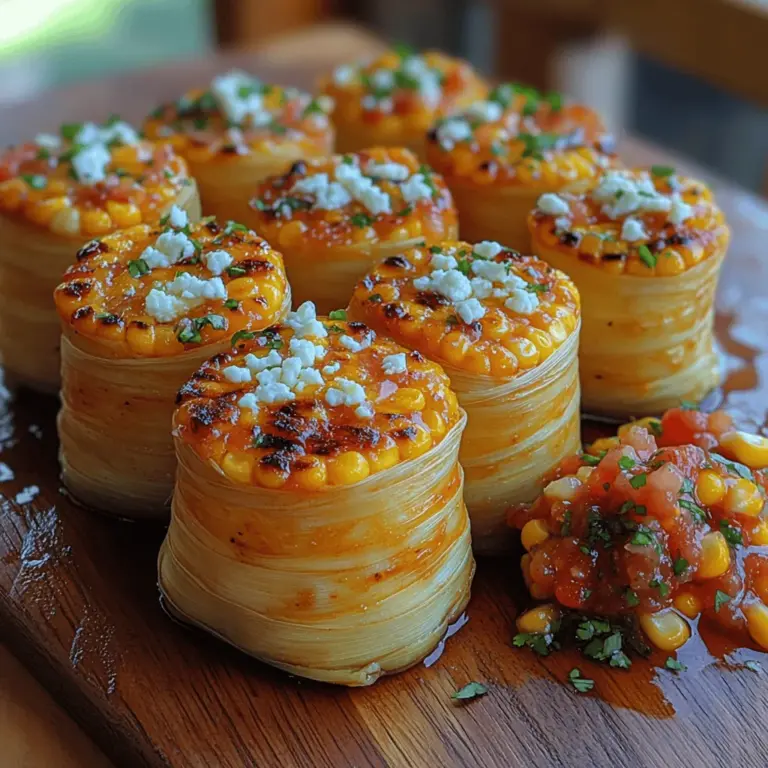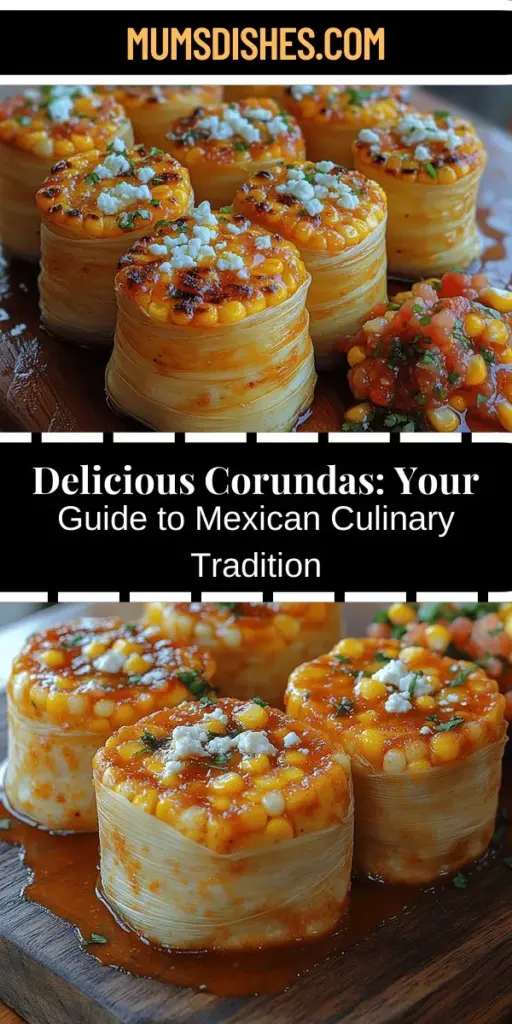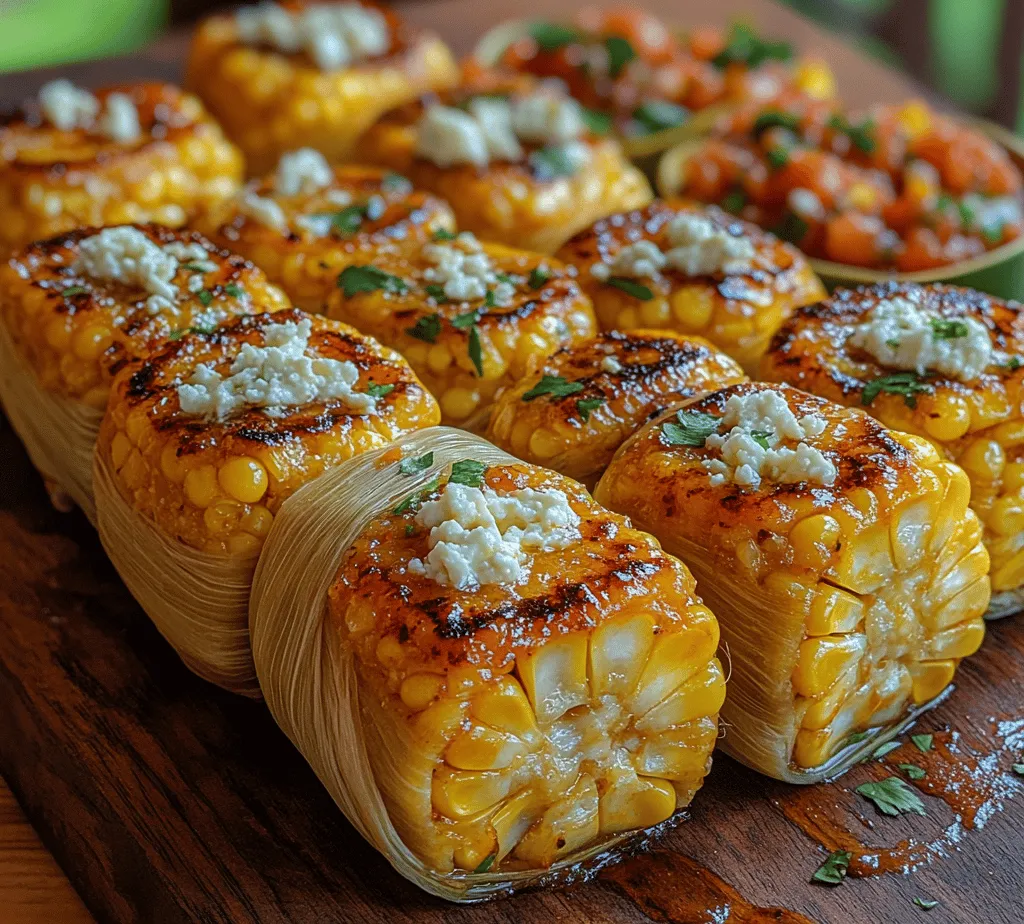Introduction
Explore the delightful world of Mexican cuisine with our recipe for Corundas Deliciosas. These traditional corn dough parcels are not only a treat for the taste buds but also a wonderful way to bring the essence of Mexican culture into your kitchen. Packed with fresh corn and the option of creamy queso fresco, corundas are perfect for serving at family gatherings or enjoying as a comforting meal. This detailed guide will walk you through the ingredients, step-by-step preparation, and serving suggestions, ensuring that you create the perfect corundas every time.
Understanding Corundas
The Cultural Significance of Corundas
Corundas have deep-rooted cultural significance in Mexican cuisine, particularly in the states of Michoacán and Guerrero. They are traditionally made during festive occasions and family celebrations, representing more than just a meal; they are a symbol of community and shared heritage. In many households, the preparation of corundas is a cherished ritual that brings families together, often involving multiple generations in the kitchen.
These corn parcels are emblematic of the indigenous culinary practices that date back centuries, highlighting the importance of corn in Mexican culture. Corn, or maize, is not only a staple food but also a symbol of life and sustenance. Thus, the act of making corundas connects people to their ancestors and the land, fostering a sense of identity and continuity.
Exploring the Origin of Corundas
The origin of corundas can be traced back to the indigenous Purepecha people of Michoacán, who have been cultivating corn for thousands of years. The word “corunda” itself is derived from the Purepecha term for these corn-based parcels. Traditionally, corundas were made using nixtamalized corn, a process that involves soaking and cooking the corn in an alkaline solution, which enhances its flavor and nutritional value.
Over time, corundas have evolved and adapted to incorporate various regional flavors and ingredients. While the classic recipe features a simple masa (corn dough) that is often filled with cheese or other savory fillings, many contemporary variations can include different meats or vegetables. This adaptability reflects the changing tastes and preferences of modern Mexican cuisine, while still honoring the dish’s rich history.
Differences Between Corundas and Other Corn Dishes
Corundas are often compared to other popular Mexican corn dishes, such as tamales and pupusas. However, they possess unique characteristics that set them apart. Unlike tamales, which are wrapped tightly in corn husks and steamed, corundas are loosely wrapped, allowing for a distinct texture that is both soft and slightly chewy. The cooking method also differs; corundas are typically steamed in a pot or a steamer, making them lighter and fluffier compared to the denser texture of tamales.
Furthermore, the masa used in corundas is usually more coarse than that of tamales, giving them a rustic feel. The inclusion of fresh corn kernels adds a burst of sweetness and moisture, enhancing the overall taste profile. While tamales are often filled with a variety of ingredients, corundas tend to focus on showcasing the flavors of the masa and the filling, making them a simpler yet equally satisfying dish.
Key Ingredients for Corundas
To prepare authentic corundas, it is essential to use high-quality ingredients that contribute to the dish’s flavor and texture. Here’s a closer look at the key components that make up this delicious recipe.
Masa Harina: The Foundation of the Dish
Masa harina is the cornerstone of corundas. This finely ground corn flour is made from nixtamalized corn, which has been soaked and cooked in limewater before being dried and ground into flour. The process of nixtamalization not only enhances the flavor of the corn but also improves its nutritional profile, making it rich in vitamins and minerals.
When selecting masa harina for corundas, look for a brand that is fresh and specifically labeled for making tamales or corundas. The quality of masa harina directly affects the final texture and taste of the dish, so it’s worth investing in a good product.
The Role of Baking Powder and Salt
Baking powder is added to the masa to create a light and fluffy texture. It acts as a leavening agent, allowing the corundas to rise slightly during cooking. This is crucial for achieving that perfect balance between a tender interior and a slightly firm exterior.
Salt is equally important in enhancing the overall flavor of the corundas. It brings out the natural sweetness of the corn and adds depth to the dish. Be sure to use a fine sea salt for even distribution throughout the masa.
Fresh Corn Kernels: Choosing the Best Option
Incorporating fresh corn kernels into the masa is what truly elevates corundas to the next level. When selecting corn, opt for fresh, sweet corn that is in season. The kernels should be plump and juicy, providing a burst of flavor with every bite. If fresh corn is not available, frozen corn can be a suitable alternative, but be sure to use high-quality, non-GMO brands for the best results.
Queso Fresco: Enhancing Flavor and Texture
Queso fresco is a traditional Mexican cheese that adds a delightful creaminess to corundas. Its mild flavor complements the sweetness of the corn, creating a harmonious balance. When choosing queso fresco, look for a fresh, crumbly variety that melts well. You can also experiment with other cheeses, such as Oaxaca or cotija, depending on your preference.
The Importance of Corn Husks
Corn husks play a vital role in preparing corundas. They serve as natural wrappers that help retain moisture during the steaming process, ensuring that the corundas remain tender and flavorful. When using corn husks, it’s essential to soak them in warm water for at least 30 minutes before wrapping the masa. This softens the husks and makes them pliable for easy wrapping.
Step-by-Step Preparation
Now that you understand the cultural significance and key ingredients of corundas, let’s dive into the step-by-step preparation process. This section will guide you through each stage, ensuring that you can create corundas that are both authentic and delicious.
Preparing the Masa
1. Soak Corn Husks: Begin by soaking the corn husks in warm water for about 30 minutes. This will make them pliable and easier to work with.
2. Combine the Dry Ingredients: In a large mixing bowl, combine 2 cups of masa harina, 1 teaspoon of baking powder, and 1 teaspoon of salt. Whisk the ingredients together until well blended.
3. Add Water: Gradually add 1 to 1.5 cups of warm water to the dry ingredients. Mix with your hands or a spatula until the dough comes together. The consistency should be soft but not sticky. Adjust with more water or masa harina as needed.
4. Incorporate Queso Fresco and Corn: Gently fold in 1 cup of fresh corn kernels and 1 cup of crumbled queso fresco into the masa dough. Ensure that the ingredients are evenly distributed throughout the mixture.
Mixing Ingredients for Optimal Texture
1. Knead the Dough: Once the corn and cheese are incorporated, knead the dough for a few minutes until smooth. This step is crucial for developing the right texture and ensuring that the masa holds together during cooking.
2. Test the Consistency: To check if the masa is ready, take a small piece and form it into a ball. Drop it into a glass of water. If it floats, your masa is ready; if it sinks, continue kneading and adding a bit more water until it passes the test.
Incorporating Fresh Corn and Queso Fresco
1. Final Mixing: After achieving the desired consistency, make sure that the corn kernels and queso fresco are evenly distributed by gently folding them into the dough once more. This will ensure that every corunda is packed with flavor and texture.
2. Prepare for Wrapping: With your masa ready, you can now start wrapping the corundas. Take a soaked corn husk, and using a spoon or your hands, spread a portion of the masa onto the center of the husk, leaving enough space on the sides for folding.
This preparation phase is crucial in creating corundas that are not only delicious but also reflect the rich culinary traditions of Mexico. Each step, from selecting the right ingredients to preparing the masa, contributes to the overall flavor and texture of the dish, ensuring that you will enjoy a truly authentic experience.
Stay tuned for the next part of this article, where we will explore the intricate process of wrapping, steaming, and serving your corundas, as well as some pro tips to elevate your dish to perfection.
Shaping the Corundas: Techniques and Tips
Shaping corundas is a crucial step that speaks to the authenticity of this traditional Mexican dish. The technique involves using masa (corn dough) to create triangular parcels, which are then filled with various savory ingredients. Here are some essential tips to ensure your corundas are shaped perfectly:
1. Masa Consistency: Before shaping, ensure that your masa is pliable but not too sticky. If it’s too wet, add a small amount of masa harina. If it’s too dry, sprinkle in a bit of water. The right texture will allow you to mold the dough without it falling apart.
2. Using Corn Husks: Soak your dried corn husks in warm water for about 30 minutes. This softens them and makes them pliable, making it easier to wrap your corundas without tearing.
3. Forming the Triangle: Take a soaked corn husk and lay it flat. Place a ball of masa in the center, approximately the size of a golf ball. Press it down with your fingers, spreading it into a triangular shape. To fold, bring the sides of the husk together, pinching them at the top to create a sealed triangle.
4. Sealing the Edges: To ensure that the filling remains inside during cooking, use a bit of masa to seal the edges. This will prevent the corundas from bursting open while steaming.
5. Batch Shaping: If you’re making a large batch, consider shaping several corundas at once. This way, you can streamline the process and reduce the time spent in the kitchen.
The Steaming Process: Ensuring Perfectly Cooked Corundas
Steaming is the final step that transforms your shaped corundas into a deliciously fluffy dish. Here’s how to do it right:
1. Prepare Your Steamer: Fill a large pot or a steamer pot with water, ensuring that the water level is below the steaming rack. Bring the water to a boil over medium heat.
2. Arrange the Corundas: Place the shaped corundas upright in the steamer basket, standing on their bases to allow steam to circulate properly. Do not overcrowd the steamer; leave some space between each corunda for even cooking.
3. Cover Properly: Place a clean kitchen towel over the corundas before covering the pot with the lid. This helps trap steam and moisture, ensuring that the corundas cook evenly and do not dry out.
4. Steaming Time: Steam the corundas for about 45 minutes to an hour. Check for doneness by carefully removing one corunda and gently pulling back the husk. The masa should be firm and easily separate from the husk.
5. Cooling Before Serving: Once cooked, let the corundas sit for a few minutes before serving. This resting time allows the flavors to meld and makes them easier to handle.
Serving Suggestions
Corundas are versatile and can be enjoyed in many ways. Here are some serving suggestions to enhance your meal:
Traditional Accompaniments to Corundas
– Crema Mexicana: A drizzle of this tangy, rich cream adds a delightful contrast to the corundas. You can make your own by mixing sour cream with a bit of lime juice and salt.
– Cheese: Crumbled queso fresco or a sprinkle of cotija cheese can elevate your corundas, adding a creamy texture and a salty kick.
– Pickled Vegetables: Serve corundas alongside a side of pickled jalapeños or onions for a zesty crunch that complements the soft masa.
Creative Salsa Pairings
– Salsa Verde: A bright and tangy salsa made from tomatillos pairs beautifully with corundas, cutting through the richness of the dish.
– Salsa Roja: For a bolder flavor, opt for a roasted tomato salsa. Its smoky undertones can enhance the overall taste experience.
– Pico de Gallo: A fresh salsa made from diced tomatoes, onions, cilantro, and lime juice can add a refreshing element to every bite.
Garnishing Ideas for Presentation
– Fresh Herbs: Garnish your corundas with fresh cilantro or parsley for a pop of color and freshness.
– Lime Wedges: Serving lime wedges on the side allows your guests to customize their flavor, adding brightness to each bite.
– Microgreens: For a modern twist, consider topping your corundas with microgreens, which add a delicate touch and sophisticated look.
Nutritional Value of Corundas
Understanding the health benefits of corundas can help you appreciate this dish even more. Here’s a breakdown:
Understanding the Health Benefits of Corn
Corn is a staple ingredient in corundas and offers several health benefits:
– Rich in Fiber: Corn is high in dietary fiber, which aids digestion and promotes a healthy gut.
– Vitamins and Minerals: It contains essential vitamins such as B vitamins (including folate) and minerals like magnesium and potassium, which are vital for overall health.
– Antioxidants: Corn is rich in antioxidants, including lutein and zeaxanthin, which are beneficial for eye health and may reduce the risk of age-related macular degeneration.
Nutritional Breakdown of Key Ingredients
– Masa Harina: Each serving of corundas typically contains about 200 calories from masa harina, along with protein (approximately 4-5 grams) and carbohydrates (around 45 grams).
– Filling Ingredients: Depending on the filling (like cheese, beans, or meats), the nutritional content may vary. For instance, cheese adds calcium and protein, while beans enhance fiber content.
Balancing Corundas with a Healthy Diet
To enjoy corundas as part of a balanced diet:
– Portion Control: Keep an eye on portion sizes, especially if you’re pairing corundas with rich toppings or sides.
– Add Vegetables: Incorporate vegetables into your filling or serve with a side salad to enhance the nutritional profile.
– Healthy Fats: Consider using avocado or olive oil as a healthier fat option when garnishing your corundas.
Variations of Corundas
Corundas can be adapted in various ways to suit different tastes and dietary preferences. Here are some creative variations:
Exploring Flavor Variations
– Cheese and Pepper: A popular variation includes mixing crumbled cheese with diced peppers into the masa, providing a deliciously cheesy and spicy corunda.
– Mushroom and Spinach: For a savory vegetarian option, sauté mushrooms and spinach with garlic, and use this mixture as a filling, offering an earthy flavor profile.
Vegetarian and Vegan Adaptations
– Plant-Based Fillings: Substitute cheese with plant-based cheese or simply use beans, lentils, or sautéed vegetables to create a hearty filling.
– Using Vegetable Broth: Instead of water, use vegetable broth to prepare the masa for added flavor, making it suitable for vegans.
Regional Variations Across Mexico
Corundas vary significantly from region to region in Mexico:
– Puebla Style: In Puebla, corundas are often served with a rich mole sauce, adding depth and complexity to the dish.
– Michoacán Style: This style features corundas made with a coarser masa, often served with a spicy salsa and picked vegetables, highlighting the region’s unique culinary traditions.
Conclusion
Corundas Deliciosas are not just a dish; they are a celebration of Mexican heritage and culinary artistry. By following this comprehensive guide, you not only learn how to prepare these delicious corn parcels but also gain insight into their cultural significance and variations. Enjoy the process of creating corundas, experimenting with fillings, and sharing them with loved ones. Embrace the rich flavors and traditions they represent, and let each bite transport you to the heart of Mexico.



